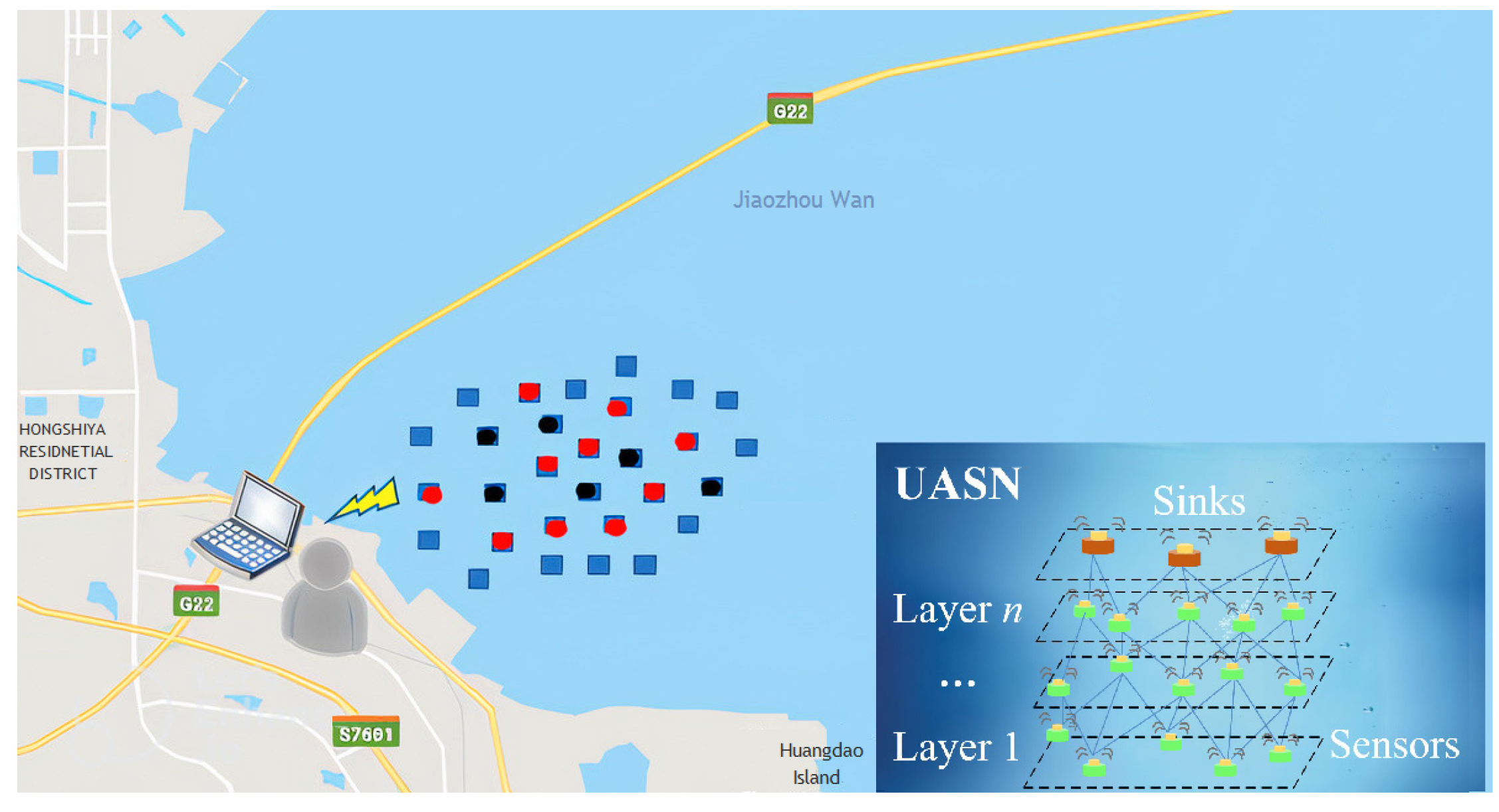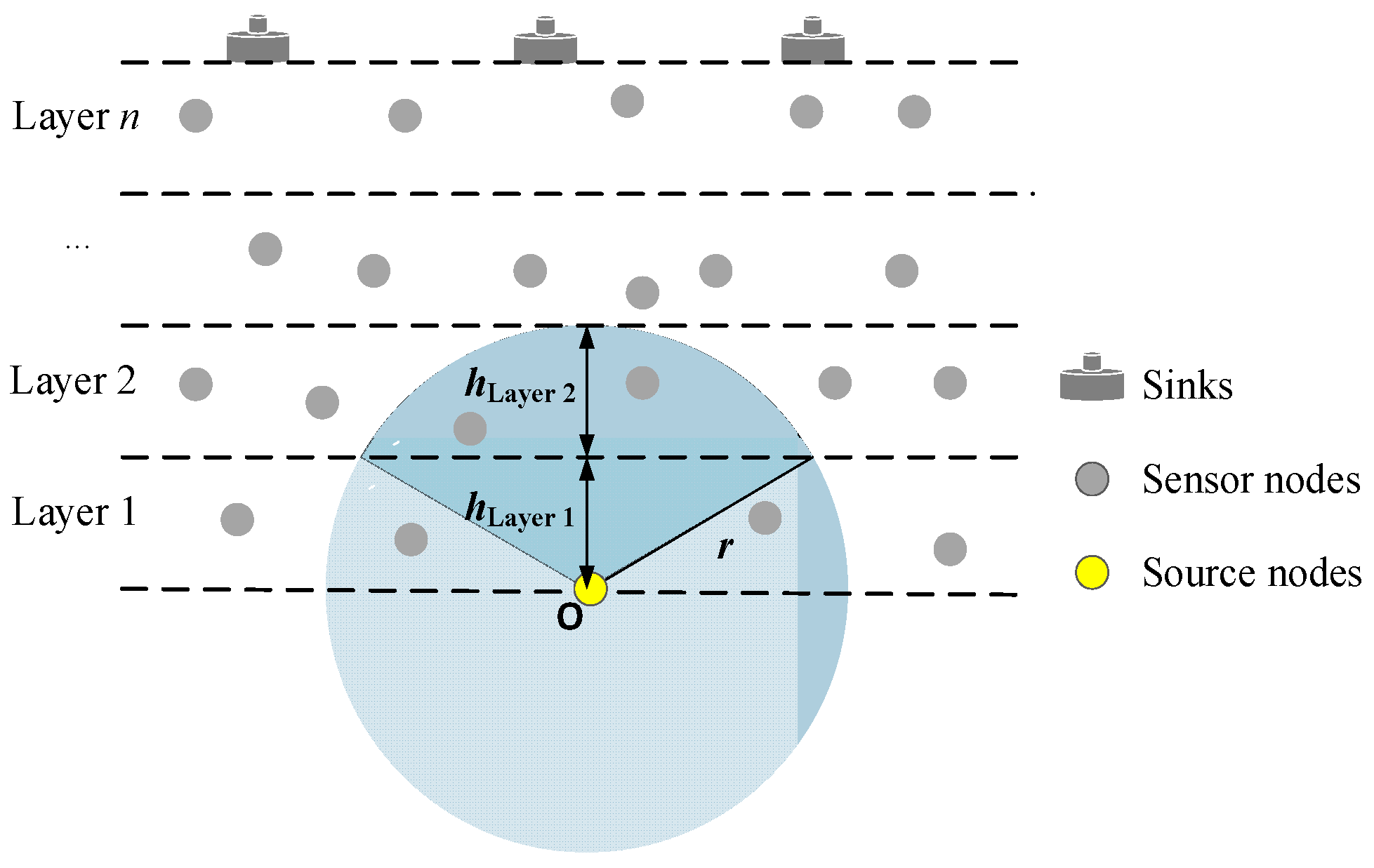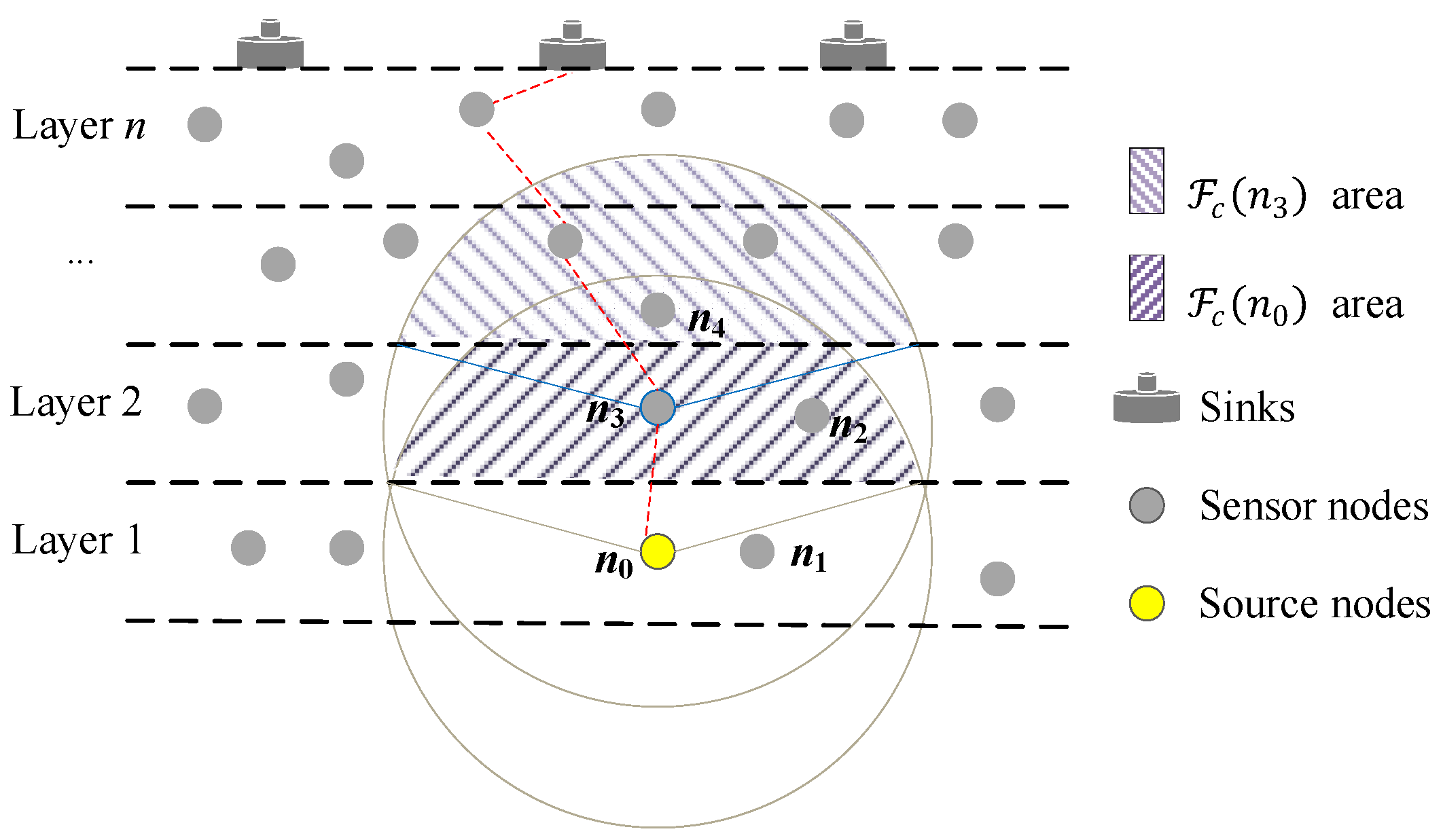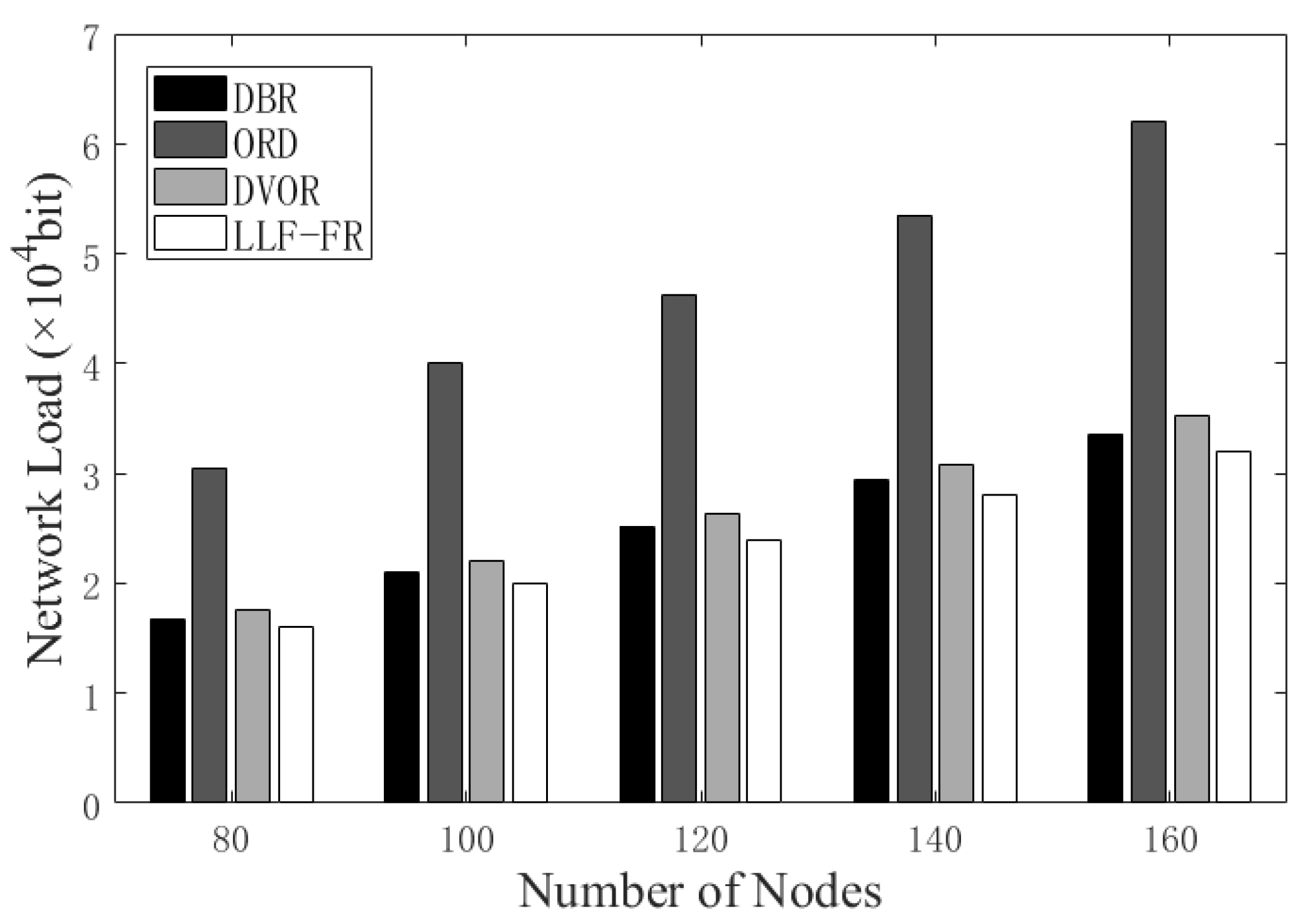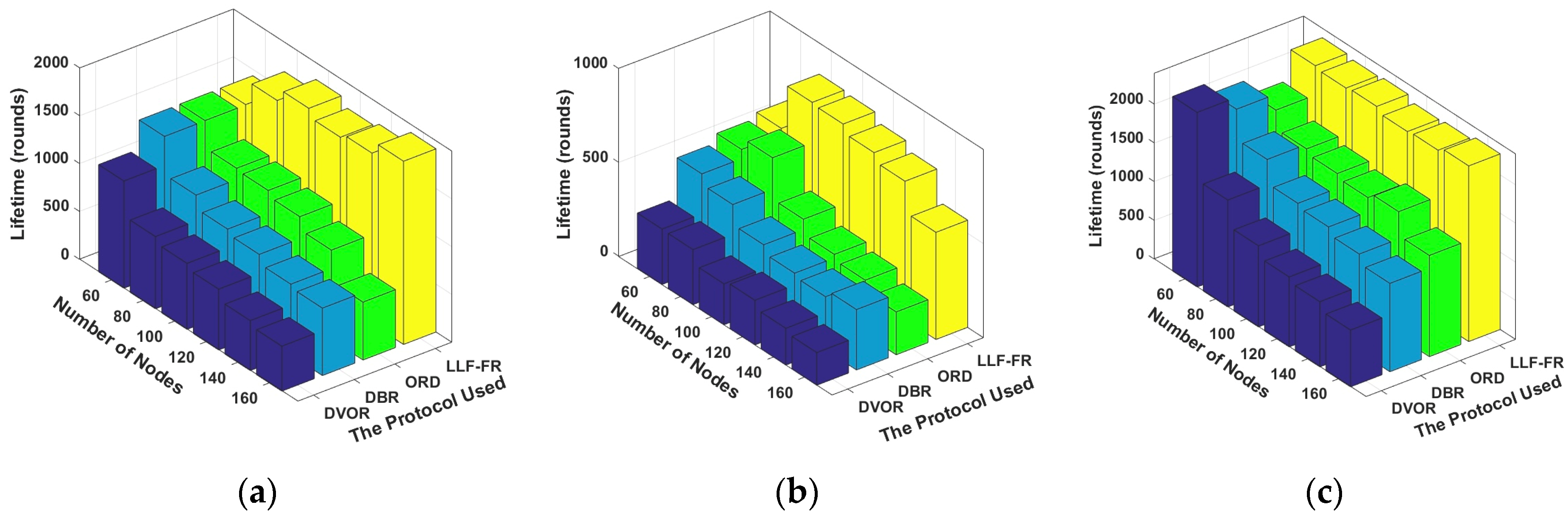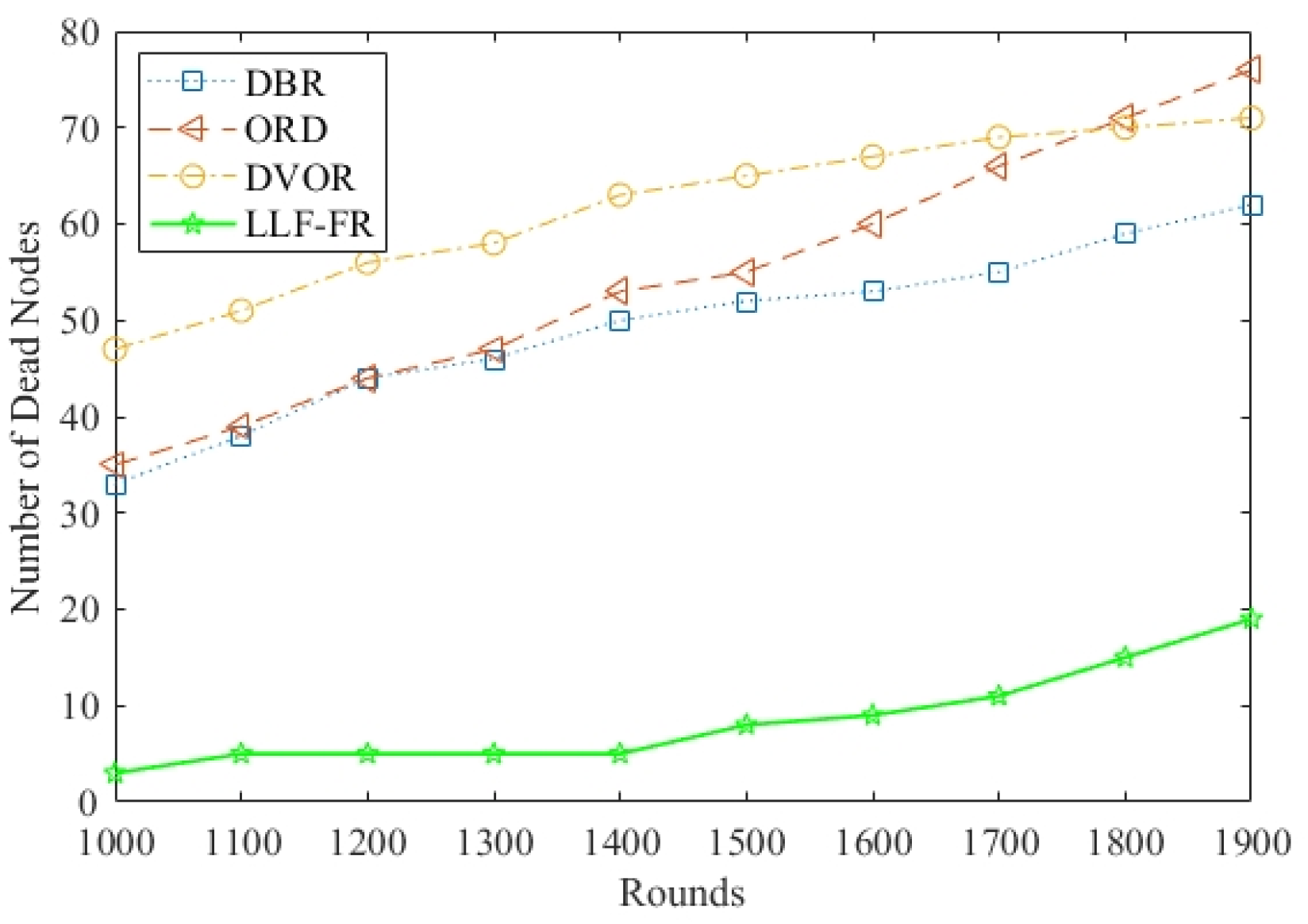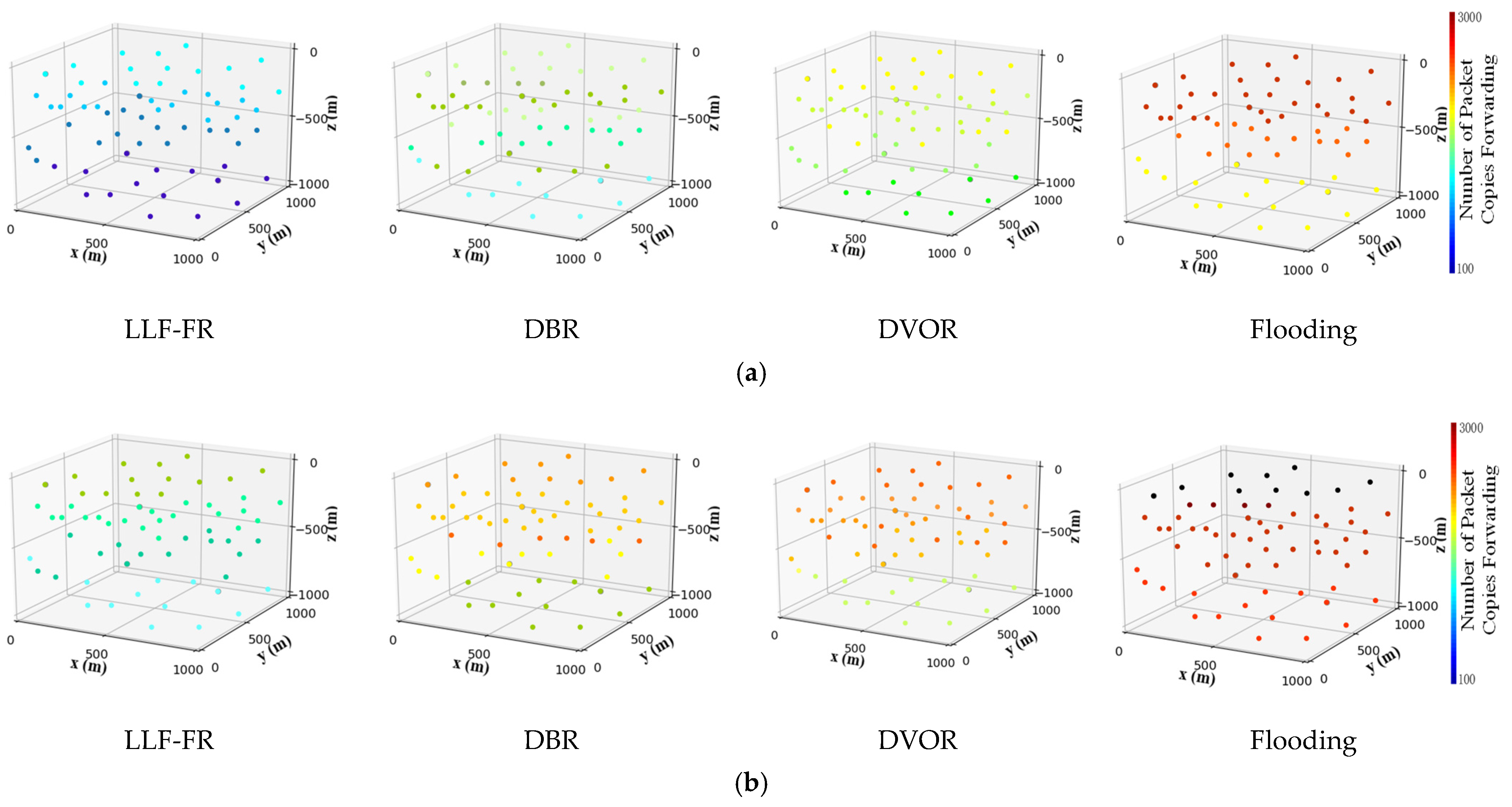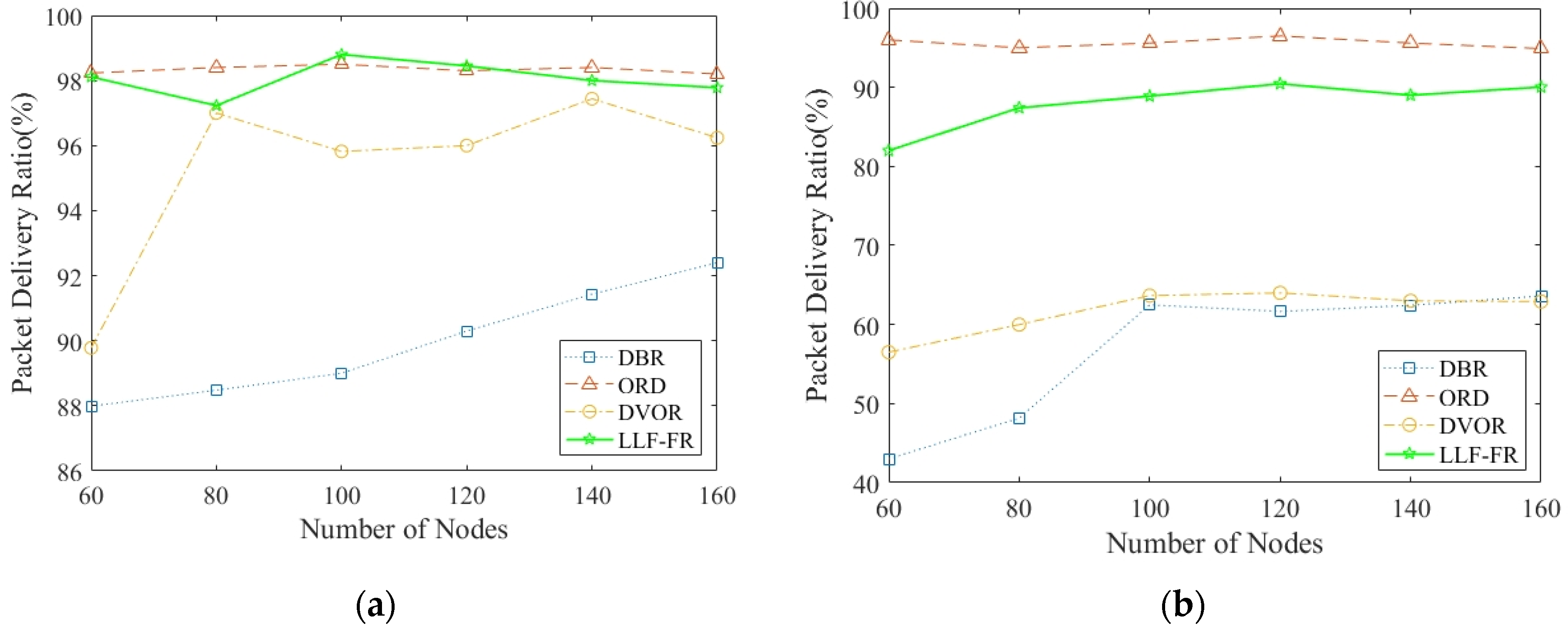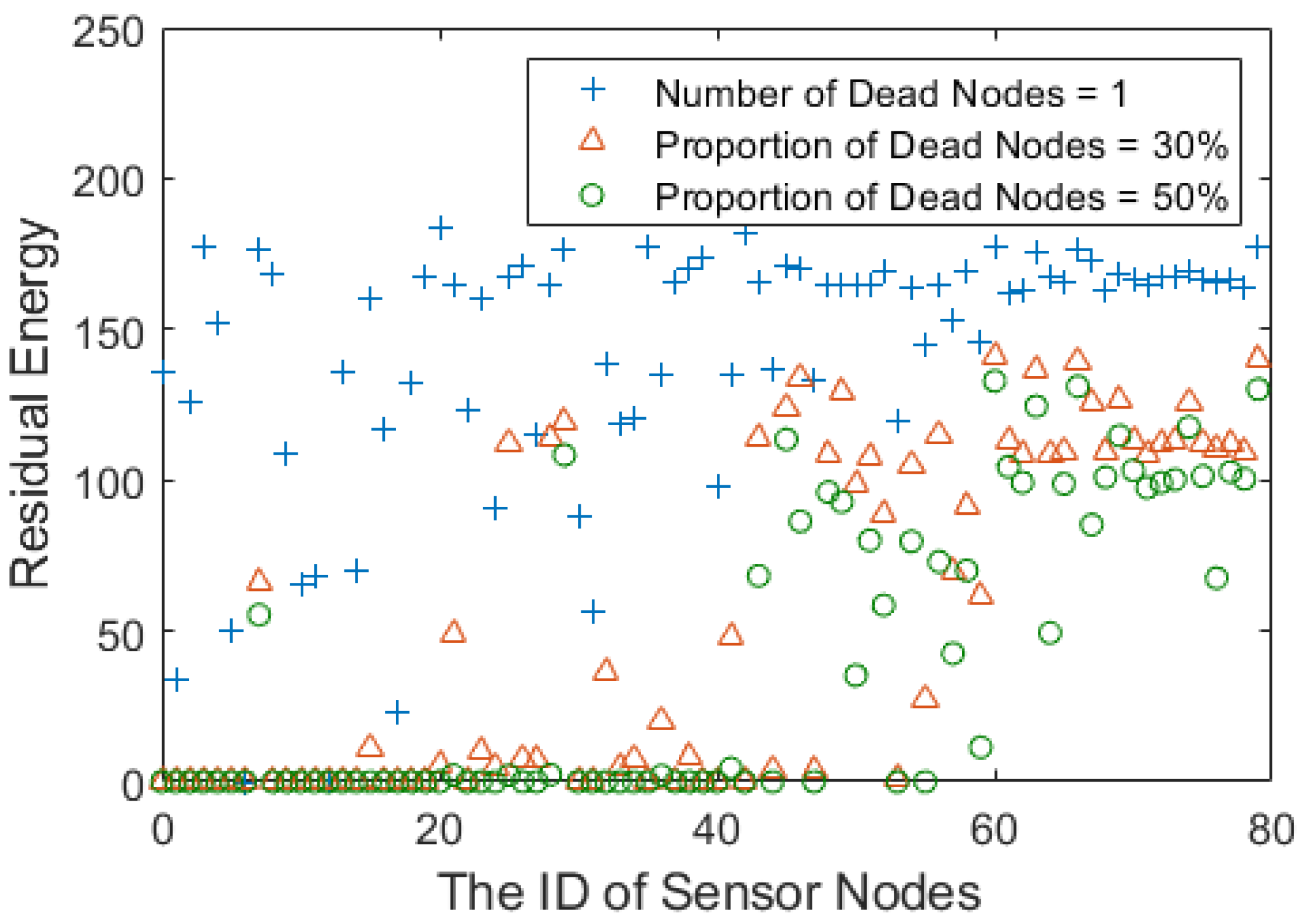1. Introduction
With the increasing intensity of marine resource development and the rapidly growing amount of marine data, underwater acoustic communication has attracted more and more attention in the underwater remote sensing field [
1,
2,
3]. Underwater acoustic sensor networks (UASNs) are widely used in marine resource exploration, data collection, environmental monitoring and marine rescue [
4,
5,
6]. However, UASNs deploy sensors with limited resources in the marine environment that are difficult to replace. When partial sensors run out of energy, UASNs do not work [
7,
8]. In the complex and varying ocean environment, underwater acoustic communication suitable for long-distance communication features long propagation delay, low bandwidth and a poor channel capability when the underwater speed of sound is about 1500 m/s, five times slower than that of radio waves (3 × 10
8 m/s) [
9]. Therefore, providing energy efficiency and reliable data transfer is the primary consideration for network performance in UASNs [
10]. Most related studies come down to trying to decrease extra communication and route void, greatly influencing a UASN’s comprehensive performance.
Redundant data transmissions increase the traffic pressure of UASNs, waste energy, and enhance the probability of data conflict and network congestion [
11,
12]. The traditional multi-hop routing protocols use unicast forwarding to choose single-route or multi-route forwarding, while they frequently exchange the collected information about the neighboring nodes to maintain the route [
13,
14]. Recently, opportunistic pouting (OR) uses broadcast forwarding by omnidirectional antennae to ensure network performance (such as the interconnection of communication, etc.), whereas multiple forwarding copies weaken the communication effect in the underwater acoustic channel and waste energy [
15]. Some directional transmissions try to adjust the effective selection range of forwarders to control duplicated forwarding [
10], while they might receive no successful forwarding ACK and cause multiple extra forwarding because coordination forwarders are not in the communication range of those with higher priority. And some location-based routing protocols and depth-based routing protocols select partial nodes toward the sinks or autonomous underwater vehicles (AUVs) as relay nodes under some routing metric, but these protocols need to transmit a longer data packet, including depth or location information, in the data forwarding process, or to interactively communicate some controlling information [
14,
16]. In addition, the uneven distribution of the load results in routing voids or long detours [
17,
18]. Therefore, extra data forwarding, redundant information exchange and uneven data load reduce the efficiency of acoustic communication and shorten the UASN lifetime [
19].
According to the existing protocols,
Figure 1 shows the ineffective network running that occurs in the environmental monitoring of a coastal area, induced by a large number of excessive and uneven data loads. Since some black nodes are frequently chosen as relay nodes to forward the data, they consume too much energy, die prematurely and cause routing voids. Red nodes carry and exchange so much controlling information as to cause frequent data conflict and heavy network congestion. The multi-forwarding of data copies also aggravates the network overload and causes transmission delay. The phenomenon brings great difficulty to marine monitoring [
20]. Because UASNs have a high deployment cost, limited bandwidth capacity, low energy efficiency, poor channel, etc., reducing redundant communication need to address the following issues: P1: A data packet contains many unnecessary controlling information. P2: Nodes need to exchange extra controlling information each other during each data transmission. P3: The broadcast feature of the omnidirectional or directional antenna enables the same data packet to be received by multiple nodes, which can lead to multiple forwarding copies. The existing protocols partially focus on P2 or P3. This paper addresses the above three issues and proposes a lightweight communication, called LLF-FR. In LLF-FR, we employ the reasonable allocation of the directional-omnidirectional hybrid transmission mode to reduce the redundancy communication as much as possible, which is different from the existing studies. The crucial contributions of our research are as follows.
To solve P1, we build a layered network model. The data packets employ layer ID, instead of depth or location information, which reduces the length of the data packet header and data transmission load. In order to solve P2, the selection of relay nodes is carried out by local computation in nodes, avoiding the regular exchange of much of the controlling information among the nodes, such as location, residual energy, and so on.
We design the layered concept to select initial candidate relays based on directional transmission, which limits the number of forwarders. Next, we propose the fuzzy model to further reduce the number of potential relay nodes as well as balance the energy consumption. Finally, the light-load efficient forwarding precisely chooses the optimum node to forward the data by random modeling. In the communication, we employ directional-omnidirectional differentiated transmission, which is different from single directional transmission where failed ACK receiving can cause some extra forwarding in the coordination process of forwarders. All these can effectively alleviate P3 and avoid multiple duplicated forwarding. Meanwhile, we consider the impact of marine acoustic velocity in the random model to coordinate the network delay.
We perform extensive simulations to verify our method under multiple performance indicators. A large number of experimental results demonstrate that our method can better reduce network load, improve the energy efficiency, balance the energy consumption, prolong the lifetime of UASNs, improve the data packet delivery ratio, and reduce the probability of data conflict and network congestion.
The remainder of this paper is organized as follows.
Section 2 presents the related work. The UASN network model, the energy consumption model and the ocean acoustic-velocity model are introduced in
Section 3. We propose the data packet format optimization based on the layered model in
Section 4.
Section 5 describes the details of the proposed method choosing the optimum forwarder, including layer-based candidate relays, fuzzy object function modeling, random forwarding modeling and directional-omnidirectional differentiated transmission. In
Section 6, the performance evaluation is discussed.
Section 7 concludes this paper. The key parameters used in this article are listed in
Table 1.
2. Related Work
In this section, we discuss the related communication protocols in USANs. They forward the data packets to the partial neighbor under some routing metric or node cooperation which can relieve P2 or P3 to some extent.
(1) Location-based routing communication. The location-based routing protocols attempt to optimize P3. The vector-based forwarding protocol (VBF) [
21] and VBF-based hop-by-hop protocol (HH-VBF) [
22] are the first location-based opportunistic routing for UASNs and establish a “routing pipe” to transmit data packets to the destination. The location information of each node is used as the route metric to select the next hop forwarders. Only nodes inside the “routing pipe” join in forwarding, which tries to reduce forwarding duplication and data load. In [
16], a typical geographic and opportunistic routing with depth adjustment (GEDAR) is proposed. The geographic information is required when deciding candidate forwarders, and the depth information is also required to avoid the route void by adjustment. The routing process wastes some energy due to lack of the energy factor. Aiming at achieving energy balance and reducing data conflicts, the energy-balanced VBF protocol [
23] uses the residual energy as the expectation factor and adjusts the coordination time in each transmission round. In [
24], a power control-based opportunistic routing (PCR) establishes a set of candidate forwarders under different transmission powers which minimizes energy consumption.
In [
8], an OR based on directional transmission (ORD) uses the coordination of neighbor nodes, the azimuth angle, the ratio of residual energy and the packet delivery ratio (PDR) as route metrics to calculate the forwarding utility of relay nodes, improving PDR, while it needs the location information and information exchange. Moreover, the directional transmission can cause multiple needless forwarding because coordination forwarders are not in the communication range of the best one and receive no forwarding ACK.
The location-based routing protocols have a tough assumption that each sensor node knows its own geographical information. They often exchange the location information among the sensors, which consume significant energy. In addition, obtaining the location information in the ocean remains another challenge.
(2) Depth-based Routing Communication. The depth-based routing protocols, partially P2 and P3. In depth-based routing communication, the nodes can obtain the depth by local pressure sensors. They are in an independent location, which avoids the regular exchange of location information [
25].
Depth-based routing (DBR) [
26] use single-metric depth difference to decide candidate relays, which greedily forwards data packets to the nodes with lower depth towards the surface sinks. DBR has no consideration for the priority rotation and balancing energy consumed among the nodes but attempts to minimize energy consumption, which causes a shorter network lifetime. In energy-efficient depth-based routing (EEDBR), the route metrics, depth and residual energy, are employed to determinate the forwarders [
27]. A set of neighbor nodes with lower depth are selected as candidate forwarders, and then the nodes with high residual energy have short holding time and forward data packets. EEDBR introduces many additional information loads and is faced with a higher maintenance cost because each node need to maintain a neighbor table by periodically sending hello packets.
Balanced energy consumption-based adaptive routing (BEAR) selects forwarders with relatively higher residual energy than those of the average network by mixed routing and cost functions by network sector division [
28]. In each transmitting period of the forwarding process, the residual energy and identifying formation of nodes are required for exchange among the nodes for calculating the average remaining energy, which severely increases the network load, whereas the method of transferring the data to sinks either direct or via multi-hop can balance energy consumption. The energy balancing routing protocol (EnOR) [
29] chooses the candidate forwarders according to the priority level decided by the remaining energy, link reliability and packet advancement. EnOR can balance the energy consumption of nodes, but it consumes a lot of energy because beacon packets are regularly broadcasted to obtain information from neighbor nodes in the routing process. In [
30], the authors propose an opportunistic void avoidance routing protocol (OVAR) to choose the forwarders under packet delivery probability and depth. In order to avoid route voids, the hidden nodes in the forwarders are discarded by the building adjacency graph in each node. The energy and depth variance-based opportunistic void avoidance scheme (EDOVE) [
31] selects the forwarding nodes with the maximum residual energy among their one-hop neighbors and more neighbors with a lower depth, to achieve energy balancing and void avoidance. To solve the route void and long detour, the distance-vector-based OR (DVOR) [
18] introduces the distance vector by a query mechanism. It records the smallest hop counts toward the sinks, along which the data packet is forwarded hop by hop. It consumes more energy since the shortest hop cannot ensure the shortest transmission distance and it transmits query packets periodically.
In the sparse UASN, a reinforcement learning-based opportunistic routing protocol is proposed to select the forwarding nodes set and cope with the routing void; the nodes in a forwarding set can monitor each other to suppress retransmission and transmission conflicts, reducing the probability of packet loss [
32]. Q-learning-based opportunistic routing (QBOR) is studied under the neighbors’ residual energy and PDR [
33]. Complex computing and information interact of nodes bring more cost to UASN with limited resources. An Objective Function (OF) is developed that uses fuzzy logic to dynamically adapt to variable environments in wireless networks, taking several metrics into account [
34]. However, when multiple metrics are similar, the OF will obtain multiple forwarding nodes, which lead to more repeated forwarding.
As illustrated in
Table 2, most communication protocols considered one or two issues still existing many redundant communications, and some protocols also pay no attention to balancing the energy consumption to decrease route void, while it proves our scheme reduces the extra data load to the most extent, and comprehensive optimizes the network performance by lightweight transmission.
4. Data Packet Optimization Based on Layered Model
The layered network is used to forward the data packets. In the data packet, the layer ID can assist the forwarding process, which does not need to carry the information of the location or depth anymore. For the purpose of reducing the overhead of the header, the format of the data packet is improved as shown in
Figure 3. Sender ID represents the source node ID, Packet ID indicates the serial number of the packet, Layer ID is the order number of the layer about the sending or forwarding node. Sender ID and Packet ID ensure the uniqueness of the data packet. Layer ID is updated hop-by-hop (layer-by-layer). Other fields remain unchanged during the forwarding process. This format reduces the transmission of extra control information. Furthermore, compared with the depth information, the Layer ID occupies fewer bits, and the length of the data packet is shorter. All of these can relieve the problem P1.
Figure 4 compares various control information that the several related routing protocols need to exchange during the communication process. It shows that the types, amount and scale of control information required by the LLF-FR are less than those of the other protocols. The black and white entries indicate various control information that needs to be carried in the header of the data packet, and the colored entries indicate various control packets that the node needs to transmit periodically. It can be clearly seen that compared with other protocols, the LLF-FR proposed in this paper requires very few types of control information (to solve P1), and does not need to exchange control packets (to solve P3), which greatly reduces the amount of information transmitted in the network. It lightens the communication load and the network energy consumption.
In different protocols, some control packages with the same name may have different types of control information, but the number of types is the same. For example, both EnOR and OVAR have control packets named as Beacon packets, but they contain different control information, as shown in
Figure 5.
5. Optimum Forwarder Decision with Directional-Omnidirectional Hybrid Mode
LLF-FR further designs the lightweight forwarder scheme to retrench the number of the forwarding node, as well as to balance the energy consumption, including the initial candidate relay node set based on the transmission layered model, the potential forwarding nodes based on the fussy model, the efficient forwarding scheme based on random modeling and the sensors’ directional-omnidirectional hybrid transmission mode. These steps precisely choose the optimum node to forward the data, can effectively cope with P3 and avoid multi-forwarding duplicates. Furthermore, the selection of the relay node set is carried out by local computation in the nodes; neither needs to regularly communicate controlling information to each other, nor do they need to carry the forwarders information in the packet header. Thus, they can also avoid P3. Consequently, the scheme can save energy, balance energy consumption, reduce the risk of data congestion and data conflicts, improve the delivery ratio of data packets and effectively use bandwidth, by the reasonable transmission reduction of control information, extra data copies, and multi-forwarding duplicates.
5.1. Candidate Relay Nodes Based on Layered Transmission
The layered model selects the nodes within the sender’s directional transmission range whose layer IDs are larger than those of the sending nodes, as candidate relay nodes, and, accordingly, pruning the range of forwarding nodes. The set of candidate relay nodes,
, is expressed as
where
N represents the neighbor nodes of the sending node, and Layer
Node j and Layer
Node i represent the layer ID of the receiving node and the sending node, respectively.
dij is the distance between the receiving node
j and the sending node
i,
r is the transmission range of sending node
i. The calculation of
dij is unnecessary because of the broadcast character of the sending node. Every Node
j that can receive the data packet from Node
i satisfies the relation,
. The
of the sending nodes decides if a node is a qualified candidate relay node. When Node
, it is a qualified candidate relay node. If Node
, it will discard the received packets.
Here, to ensure that the nodes located near the boundary of each layer can achieve cross-layer communication, we define the reference relation between the node transmission radius
r and the layer height as
where
hLayer i is the height of Layer
i, and
hLayer i+1 is the height of Layer
i + 1.
Figure 2 shows an example of the boundary Node
O.
In addition, according to assumption 1, the transmission range of the node can be adjusted by the power control. In this way, if the nodes encounter the void region, the transmission range can be expanded appropriately to explore the forwarding nodes. We can evaluate the number of candidate forwarding nodes for each node. We set the node density of UASN as , and the volume of the upper candidate region within the directional transmission range of the sending node as Vi. Then, the number of candidate relays of sending nodes can be obtained as . Therefore, we can set suitable to adjust the number of candidate relays, and adjust the node power to successfully find the forwarder. The forwarding of data packets will fail only if all nodes in the forwarding set are unable to transmit the data packets.
5.2. Fuzzy-Modeling-Based Potential Relay Nodes
It is necessary for designing the optimum forwarding plan to refer to many performance aspects such as the load, energy, energy consumption balance, delay time, etc. and the corresponding metrics. LLF-FR introduces the fuzzy model that can set many metrics to set the priority level of the candidate relay nodes according to the real requirements. When the data arrive at the candidate relay nodes of
, the nodes with highest priority are chosen as the potential relay nodes
. Each node has many linearly independent metrics. We define the metrics set of Node
j as the linear matrix
and the normalized vectors matrix as H. Then, the priority of candidate relay node
j is calculated by
where
mi (
i = 0, 1, …,
k) represents each available metric for Node
j, and
k is the number of available metrics.
γi is the normalized vector corresponding to each metric. We set one normalization vector, because each metric has the same value range no matter which node.
αi (
i = 0, 1, …,
k) represents the coefficient corresponding to each metric
mi, which is adaptive and can be adjusted according to the real application.
The metrics in the fuzzy model can be set according to each real case and can satisfy the overall performance requirement. Here, we made a detailed design. In order to balance the energy consumption of each node, we need to set the remaining energy as one metric. Because each node’s energy is almost the same at the beginning, if only using the remaining energy as one metric to calculate the priority, each node will have the same priority and forward the data copies at the same time. We considered the depth as another metric and chose the relay node according to the depth, which can avoid too many nodes in
simultaneously forwarding a lot of duplicated data, although this method cannot even out the energy consumption. Therefore, we chose
Eo −
Er, the difference between the initial energy
Eo and the residual energy
Er, as
m0 and chose the depth metric as
m1. The corresponding energy normalized vectors were defined
γ0 =
Eo, and
γ1 is the depth of the deepest node in Layer 1. The coefficient (
α0,
α1) is defined as
where the residual energy
Er =
Eo −
m0,
Elow is the lowest node energy limitation to transmit data packet,
Eo is the initial node energy and
λ is the threshold. When the node energy is below
Elow, it can hardly send data packets anymore. When the energy of each node is almost equal to
Eo, the depth metric will be main factor to select the forwarding node. In the other condition, the node with the biggest
Er will forward the data in turns. Thus, we could take turns to choose the candidate relay nodes according to their priority to balance the energy consumption. And we calculated the Priority
j of each Node
j . Finally, we can obtain the fuzzy-based objective function:
where
is the candidate relay nodes set of sending node
i. According to the above objective function formula, the nodes with the lowest score of Priority
j are further chosen as the potential relay nodes set,
.
Algorithm 1 shows the implementation process of
, Priority
j,
Oj,
.
| Algorithm 1 , Priorityj, |
Input: sensor nodes, sinks, Eo, Er, Layer ID, Depth, Elow, λ, γ1
Output: , Priorityj,
1. while Node j receives the packet Pi do
2. Obtain the Layer ID of Pi;
3. if Layer ID of Node j > Layer ID of Pi then
4. Put Node j into ;
5. endif
6. return
7. endwhile
8. for j
9. Compute Priorityj, Oj by (9)–(11);
10: endfor
11: Choose nodes with lowest Oj into |
5.3. Random Modeling
We can obtain fewer forwarding nodes from the potential relay node set by the fuzzy model function Oj. However, when Eo and the depth of several nodes are similar, they will have the same score of Priorityj, and forward the data packets repeatedly, which can also result in redundant transmission. Hence, LLF-FR proposes a random modeling to enhance the priority and coordination of the potential relay nodes. When the data packet arrives at the nodes in , the nodes keep the data packets for short coordination holding (CoH) time. The node with shorter CoH time will participate in forwarding. If a node forwards the data packet successfully, the other nodes in potential relays will receive the information of the data packet successfully forwarded. Thus, they know the transmission of that packet by a node with a shorter CoH time, then stop the forwarding schedule and discard the data copies.
For example, in
Figure 6, nodes
n2,
n3,
n4 are in the
, and nodes
n2 and
n4 are in the transmission range of node
n3. When node
n3 with the shortest
CoH time successfully forwards the data packet from node
n0, nodes
n2 and
n4 will discard the same data packet from node
n0 and stop forwarding its duplicated packet. This way further reduces the data load and the probability of packet collisions. We defined the
CoH time of Node
j as
where
μ,
η,
β indicate the adjustment coefficient, which can be set according to the real situation, and
r represents the transmission range of the node. The acoustic velocity
C is from (6), and
is the average sound propagation speed in the ocean (usually set to 1500 m/s). The LLF-FR model introduces
C varying with the different ocean depth to the
CoH time model, aiming at coordinating the network time-delay. The model adopts a random number
rand (0.1,
σ) to appropriately adjust the
CoH time difference of nodes where
σ is a predefined value range and can be defined according to the requirements of the application environment. The random number can prevent other low-priority potential nodes from repeated forwarding if they do not receive the forwarding information from higher-priority node in time. The
CoH time difference of any two potential nodes must be more than
r/
in order to ensure that the low-
CoH time nodes in the same potential relays set can hear the forwarding of high-
CoH time nodes and give up the extra forwarding, when a node with shortest
CoH time forwards the data packets successfully. Our LLF-FR can ensure this condition, the
CoH time difference of any two nodes in
is more than
r/
.
Appendix A gives the related theorem and proof. Therefore, this way can try to avoid extra forwarding duplicates both from the potential relay nodes in
with the same Priority
j and from multiple nodes having similar
CoH time, further cut down extra multi-forwarding.
Here, the values of β and the difference of any two nodes influence the CoH time. When σ is smaller, is also smaller; accordingly, the CoH time and network delay are reduced. There may exist more nodes with the same CoHj repeating the forwarding when σ is smaller. However, the obtained by the fuzzy model ensures fewer potential forwarding, which can make smaller σ possible and avoid too much network delay. If the real communication has higher requirements for time delay, the value of β will be adjusted lower; meanwhile, several forwarding nodes will have similar delay time, forward the data packet at the same time, and cause few extra data packets. If the real communication has higher requirements on channel utilization, the value of β will be larger. At this time, the small time delay will be sacrificed, but the number of multiple forwarding nodes can be reduced as much as possible. This avoids the forwarding of many extra data packets and improve the channel utilization rate.
5.4. Directional-Omnidirectional Hybrid Mode
According to the layered forwarding model, Layer 1 is the lowest layer. Therefore, the nodes of Layer 1 only send the data packets generated by themselves and they do not need to play the role of the relay nodes. However, the nodes in other layers not only send their own data packets, but also forward the data packets from lower layer nodes. To refine the forwarder number and reduce the broadcast storm, the source sensors generating and sending the data packet employ directional transmission (e.g.,
n0 in
Figure 2). In the process of forwarder collaborative competition, only the sensors (e.g.,
n2 and
n4 in
Figure 6) in the transmission range of the sensor (e.g.,
n3 in
Figure 6) successfully forwarding the data packet can receive the information and stop its own forwarding schedule. If the successful forwarder uses directional transmission (e.g.,
n3 in
Figure 6), some sensors cannot receive the information successfully forwarding (e.g.,
n2 in
Figure 6), and then continue to forward the needless data copies. Considering the stripped-down number of candidate relay sensors decrease the extent of broadcast storm, we set the omnidirectional transmission for the forwarders to avoid the above case.
So, the source sensor nodes and the forwarding sensor nodes of upper layer (Layer
i (
i ≥ 2)) run different algorithms. The running of the source sensor nodes is illustrated in Algorithm 2. Algorithm 3 summarizes the transmission details of forwarding sensor nodes. For preventing the packets from the broadcast storm, we set the AP buffer and CP buffer for each node. The AP buffer of the node records the packet ID of the packet that has already been forwarded, and the CP buffer temporarily records the current packets waiting for forwarding. When each node finds that its receiving packet ID has existed in the AP buffer, it indicates that that packet has been forwarded and the node will drop the packet. If the receiving packet has existed in CP buffer, it indicates that the current node has known that the receiving packet has been forwarded by a potential forwarder with the shortest
CoH time. Therefore, the packet will be discarded and the Packet ID will be added to the AP buffer. If neither of these conditions are met, the receiving packet will add to the CP buffer, update the Layer ID of the packet header and start a
CoH timer according to (12). Once the shortest
CoH timer ends, the packet in CP buffer will be forwarded immediately.
| Algorithm 2 Data Transmission of Source Sensor Nodes |
Input: Eo, r, Layer ID, Depth
Output: action of sensor node
1. while sensor node in Layer i generates Packet Pi do
2. Broadcasts Packet Pi by directional transmission mode
3. endwhile |
| Algorithm 3 Data Transmission of Forwarding Nodes |
Input: Eo, r, Layer ID, Depth, μ, η, β, C, , Priorityj
Output: action of sensor node
1. while sensor Node j in Layer i receives Packet Pi do
2. if Layer ID of Node j = 1 then
3. Discards Packet Pj
4. else
5. Obtain Packet ID, Layer ID of Pi;
6. if Node , then
7. Look up AP buffer;
8. if Packet ID of Pi is in AP buffer then
9. Discard Packet Pi;
10. else
11. Update Layer ID in Pi;
12. Calculate CoHj by (12);
13. Look up CP buffer;
14. if Packet ID of Pi is in CP buffer then
15. Discard Packet Pi and remove Pi ID from CP buffer;
16. else
17. Add Packet Pi into CP buffer;
18. endif
19. Forward Packet Pi after CoHj ends by onmidirectional mode;
20. endif
21. else if then
22. Look up CP buffer;
23. if Pi is in CP buffer, then
24. Discard Packet Pi and remove Pi ID from CP buffer;
25. else
26. Discard Packet Pi;
27. endif
28. endif
29. endif
30. endwhile |
7. Conclusions
This paper analyzed the characteristics of underwater acoustic communication and the focus of existing mainstream studies, and summarized three sources of redundant communication impacting the UASN comprehensive network performances, which presents a basis for studying better data-transmission protocols. And then LLF-FR optimization of the network overhead was designed by solving the three sources to suppress the extra data load. LLF-FR optimized the header controlling information and the length of the data packet, based on the layered network model, to refine the data load in the data transmission. The number of forwarders was cut down step-by-step by the candidate relay-nodes set, the fuzzy model, and the random model. Different from the single transmission mode, the reasonable allocation of the directional-omnidirectional transmission mode decides the optimum forwarding node with which to transfer data packet and efficiently limits the forwarding copies. Meanwhile, the defined forwarding models can take turns to choose the forwarder, which ensures the balancing load and an even energy consumption. The time delay was also coordinated considering the impact of the marine acoustic velocity in the random modeling. In addition, the selection of forwarding nodes was carried out by the local computation in nodes, avoiding the regular exchange of abundant controlling information. Therefore, LLF-FR strictly restricted redundant communication in UASN and the simulation results demonstrate that LLF-FR effectively limits redundant information, improves energy efficiency, balances energy consumption, prolongs the network lifetime, reduces data conflict and data jam, and increases the packet delivery ratio compared with other protocols. It can greatly enhance the comprehensive performances of UASNs.
